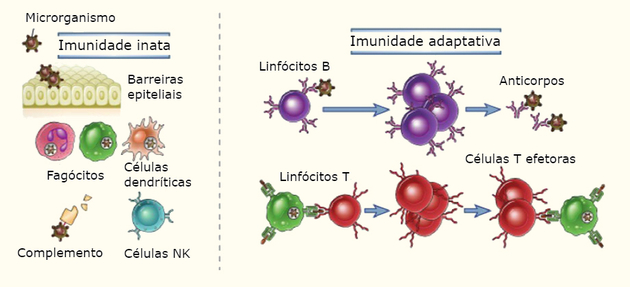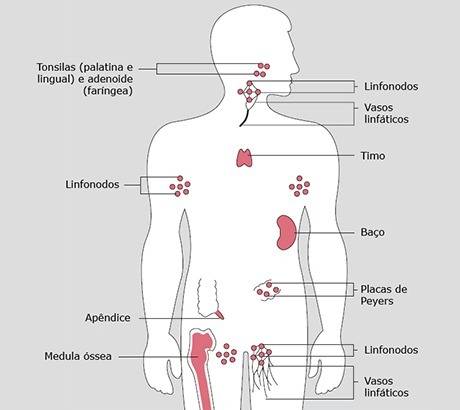The immune system, immune system or immune system is a set of elements that exist in the human body.
These elements interact with each other and aim to defend the body against diseases, viruses, bacteria, microbes and others.
The human immune system serves as a shield, shield or barrier that protects us from unwanted beings, the antigens, that try to invade our bodies. Thus, it represents the defense of the human body.
Immune response

The body's defense process through the immune system is called the immune response.
There are two types of immune responses: innate, natural or nonspecific, and acquired, adaptive or specific. Learn about each type of immune response in the explanations below.
Innate immunity, natural or non-specific
Innate or natural immunity is our first line of defense. This type of immunity is born with the person, represented by physical, chemical and biological barriers.
See in the table below what they are and how they act in our body's defense.
| Barrier | action in the organism |
|---|---|
| Skin | It is the main barrier the body has against pathogens. |
| Eyelashes | They help protect the eyes, preventing the entry of small particles and in some cases even small insects. |
| Teardrop | Cleans and lubricates the eyes, helping to protect the eyeball from infections. |
| Mucus | It is a fluid produced by the body that has the function of preventing microorganisms from entering the respiratory system, for example. |
| platelets | They act in the clotting of blood that, when faced with an injury, for example, they produce a network of wires to prevent the passage of red blood cells and retain the blood. |
| Spittle | It has a substance that maintains the lubrication of the mouth and helps protect against viruses that can invade the organs of the respiratory and digestive system. |
| Gastric juice | It is a liquid produced by the stomach that acts in the process of digesting food. Due to its high acidity, it prevents the proliferation of microorganisms. |
| Sweat | It has fatty acids that help the skin to prevent fungus from entering the skin. |
Innate immunity is also represented by defense cells such as leukocytes, neutrophils and macrophages, which is described below.
The main mechanisms of innate immunity are phagocytosis, release of inflammatory mediators and protein activation.
If innate immunity doesn't work or isn't enough, acquired immunity kicks in.
Learn more about:
- Skin
- platelets
- Spittle
Acquired, adaptive or specific immunity
Adaptive immunity is lifelong acquired defenses such as antibodies and vaccines.
It constitutes mechanisms developed to expose people in order to evolve the body's defenses. Adaptive immunity acts on a specific problem.
Therefore, it depends on the activation of specialized cells, lymphocytes.
There are two types of acquired immunity:
- humoral immunity: depends on the recognition of antigens through B lymphocytes.
- Cellular immunity: cell-mediated defense mechanism through T lymphocytes.
read about:
- antigens
- Antibodies
- child vaccination
Cells and Organs
The human immune system is made up of different types of cells and organs, which are divided as follows:

See below for details on how each of these cells and organs act in the body's defense.
cells
The body's defense cells are leukocytes, lymphocytes and macrophages.
Leukocytes
Leukocytes or white blood cells are cells produced by the bone marrow and lymph nodes. They have the function of producing antibodies to protect the body against pathogens.
Leukocytes are the main agent of our body's immune system.
They are leukocytes:
- Neutrophils: envelops the diseased cells and destroys them.
- eosinophils: act against parasites.
- basophils: related to allergies.
- Phagocytes: perform phagocytosis of pathogens.
- monocytes: penetrate tissue to defend against pathogens.
Know more:
- Leukocytes
- Phagocytosis
- Lymphatic system
Lymphocytes
Lymphocytes are a type of white blood cell or white blood cell, responsible for recognizing and destroying infectious microorganisms such as bacteria and viruses.
There are B lymphocytes and T lymphocytes.
Learn more about:
- Lymphocytes
- Diseases caused by bacteria
- Virus Diseases
Macrophages
Macrophages are cells derived from monocytes. Its main function is to phagocytose particles, such as cell debris, or microorganisms.
They are responsible for initiating the immune response.
Organs

The organs of the immune system are divided into primary and secondary immune organs.

Primary Immune Organs
In these organs, lymphocytes are produced:
- bone marrow: soft tissue that fills the inside of bones. Place of production of the figured elements of blood, such as red blood cells, leukocytes and platelets.
- thymus: gland located in the thoracic cavity, in the mediastinum. Its function is to promote the development of T lymphocytes.
Also read about:
- bone marrow
- thymus
Secondary Immune Organs
In these organs, the immune response is initiated:
- Lymph nodes: small structures formed by lymphoid tissue, which are found in the path of lymphatic vessels and are spread throughout the body. They filter the lymph.
- Spleen: filters the blood, exposing it to macrophages and lymphocytes which, through phagocytosis, destroy foreign particles, invading microorganisms, red blood cells and other dead blood cells.
- Tonsils: Consisting of lymphoid tissue, rich in white blood cells.
- Appendix: Small lymphatic organ, with a high concentration of white blood cells.
- Peyer's plates: accumulation of lymphoid tissue that is associated with the intestine.
Also learn about:
- Lymph nodes
- Spleen
- Appendix
Low immune system
When the immune system doesn't function properly, it diminishes its ability to defend our body.
Thus, we are more vulnerable to diseases such as tonsillitis or stomatitis, candidiasis, skin infections, ear infections, herpes, flu and colds.
To strengthen the immune system and avoid problems with low immunity, special attention is needed with food. Some fruits help boost immunity, such as apples, oranges and kiwis, which are citrus fruits. ingestion of Omega 3 it is also an ally for the immune system.
It is also important to exercise, drink water and sunbathe in moderation.
To learn more, read also:
- Human Body
- Human Body Systems

